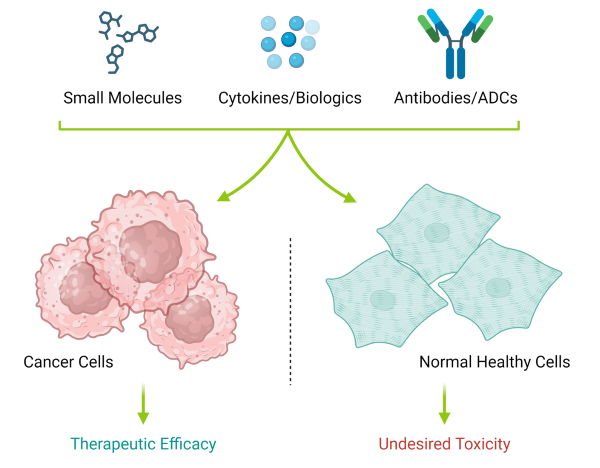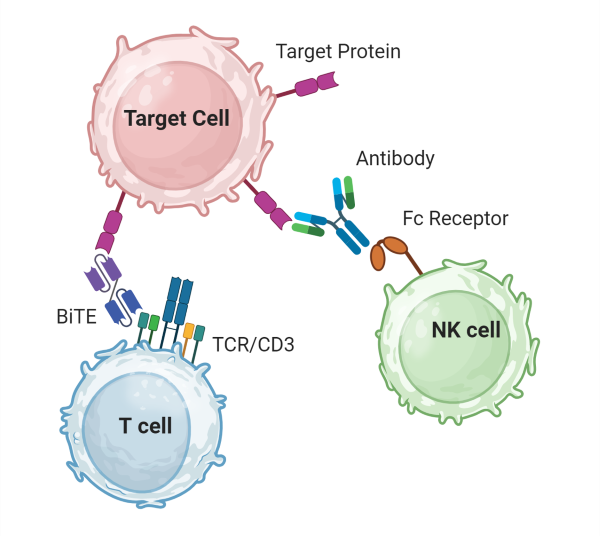Cell Cytotoxicity Screening & Profiling Services
Small Molecule Cell Cytotoxicity Assays
Understanding cell cytotoxicity, either as a result of targeted therapy or as a side effect, is important in drug development. Our expert scientists can help determine effective dose curves for your molecules of interest in whole cell assays, whether they are small molecules or biologics, including antibody drug conjugates. Over 30 different tumor cell lines are available to model human tumor types, including lung, breast, ovarian, pancreatic, and colorectal carcinomas, leukemias, and lymphomas. You can also select primary cells such as PBMCs or iPSC-derived cells, or choose from our genetically engineered cell lines, overexpressing proteins of interest. We accurately measure cell viability, proliferation, and death using a robust ATP-dependent homogeneous assay that demonstrates high linearity from 100 to 200,000 cells per well in 96-well plates, capable of supporting high throughput capacity. Alternatively, cancer cells constitutively expressing luciferase can be used, providing a simple and rapid readout for cell numbers.

Cell-Dependent Cytotoxicity Assays
If the mechanism for cell-killing requires functional killer cells, we can also provide screening and profiling services to evaluate your drug candidates. Our expert scientists can screen your conventional antibodies, multi-specific antibodies, and bispecific T cell or NK cell engagers, using cytotoxic T cells and NK cells and the appropriate target expressing cells. We have a number of validated systems ready for use in screening assays, which include positive control antibodies and BiTEs. We can also develop custom target cells and custom assay systems to deliver the best results for your needs. Development, testing, and validation of CAR constructs are also available.
Request QuoteLearn more about the process and deliverables.

Available Cells for Testing
Tumor Cell Line
A2780, human ovarian carcinoma
A549, human lung carcinoma
BT-474, human breast adenocarcinoma
BxPC-3, human pancreatic carcinoma
Daudi, human B cell lymphoma
HCT116, human colorectal carcinoma
HeLa, human hepatocellular carcinoma
Jurkat, human acute T cell leukemia
MCF-7, human breast adenocarcinoma
MDA-MB-231, human breast adenocarcinoma
MDA-MB-468, human breast adenocarcinoma
MIA PaCa-2, human pancreatic carcinoma
NALM6, human acute lymphoblastic leukemia
Neuro2A, mouse neuroblastoma cell line
NIH:OVCAR-3, human ovarian carcinoma
PANC-1, human pancreatic carcinoma
PC-12, rat pheochromocytoma
Raji, human B cell lymphoma
SK-BR-3, human breast adenocarcinoma
SK-OV-3, human ovarian carcinoma
THP-1, human acute monocytic leukemia
U937, pro-monocytic, human histiocytic lymphoma
UTSCC5, human squamous cell carcinoma
UTSCC8, human squamous cell carcinoma
UTSCC9, human squamous cell carcinoma
UTSCC10, human squamous cell carcinoma
UTSCC14, human squamous cell carcinoma
UTSCC16A, human squamous cell carcinoma
UTSCC16B, human squamous cell carcinoma
UTSCC24A, human squamous cell carcinoma
Primary and iPSC-Derived Cells
Human iPSC-Derived Cardiomyocytes
Luciferase Cell Lines
eGFP/Firefly Luciferase U-87 MG
Overexpression Cell Lines
*Cell line lists may not be comprehensive. Inquire with us for more information.
Service Inquiry
│Related Services
- Cell Signaling Pathway Screening Services
- Immunotherapy Cell-Based Screening Services
- Custom Cell-Based Assay Development
- Custom Cell Line Development
- Custom CAR-T Cell Development
│Related Products
- Cell Lines
- iPSC-derived Cardiomyocytes
- Primary Cells
- PBMC Cytotoxicity Assay Kits
- CDX Model Cell Lines

